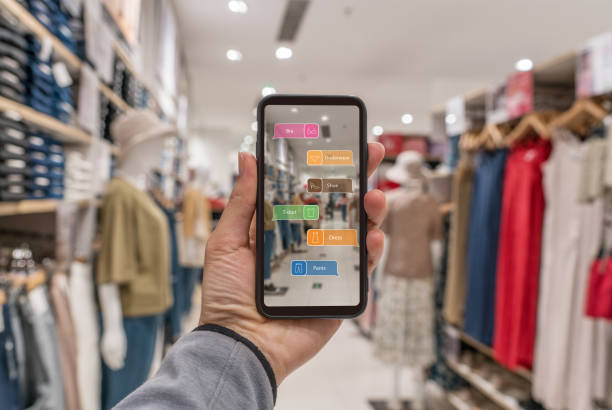
In recent years, the retail landscape has experienced a dramatic shift, largely driven by technological advancements. Among these, Augmented Reality (AR) has emerged as a game-changer, reshaping how consumers interact with brands and make purchasing decisions. By blending the physical and digital worlds, AR offers retailers innovative ways to engage customers, boost sales, and enhance customer satisfaction.
In this blog, we’ll explore how augmented reality is being used in retail, the benefits it brings to businesses and consumers, and what the future holds for this exciting technology.
What is Augmented Reality in Retail?
Augmented Reality (AR) is a technology that overlays digital content—such as images, sounds, and interactive elements—onto the real world using devices like smartphones, tablets, or AR glasses. Unlike Virtual Reality (VR), which immerses users in a completely virtual environment, AR enhances the real world by adding digital elements to it.
In retail, AR bridges the gap between online and in-store shopping, providing customers with a richer and more interactive shopping experience.
Key Applications of Augmented Reality in Retail
1. Virtual Try-Ons
One of the most popular applications of AR in retail is virtual try-ons. From clothing to makeup and eyewear, AR allows customers to see how products will look on them without physically trying them on.
- Fashion and Apparel: Brands like Zara and ASOS have implemented AR fitting rooms, enabling shoppers to visualize outfits on a virtual model or even themselves.
- Beauty and Cosmetics: Sephora’s Virtual Artist app allows customers to test different shades of lipstick or eyeshadow using their smartphone camera.
- Eyewear: Warby Parker’s AR feature lets customers try on glasses virtually, helping them find the perfect fit and style.
2. Interactive Product Previews
AR allows customers to preview products in their real-world environment before making a purchase.
- Furniture and Home Decor: IKEA Place is a prime example, enabling users to place virtual furniture in their homes to check for fit and style.
- Electronics: Samsung and Apple offer AR tools to showcase how devices will look in a user’s home or workspace.
3. In-Store Navigation
Large retail stores can often be overwhelming, but AR can simplify the shopping experience with interactive navigation.
- Wayfinding: AR-enabled apps guide customers to specific aisles or products using their smartphone cameras.
- Enhanced Engagement: AR can also provide additional product information, reviews, or promotional offers when customers point their device at a specific product.
4. Gamified Shopping Experiences
Retailers are using AR to turn shopping into an engaging and entertaining activity.
- Treasure Hunts: Popularized by brands like Target, AR treasure hunts encourage customers to explore the store in search of hidden deals.
- AR Games: By integrating AR games into their apps, retailers can attract younger audiences and increase time spent in-store or on the app.
5. Personalized Marketing Campaigns
AR makes marketing campaigns more interactive and memorable. For example, Coca-Cola used AR-enabled billboards that came to life when scanned with a smartphone, creating an engaging and shareable experience.
Benefits of Augmented Reality in Retail
For Retailers:
- Increased Sales: By allowing customers to visualize products, AR reduces purchase hesitation and increases conversion rates.
- Reduced Returns: With virtual try-ons and product previews, customers make more informed choices, leading to fewer returns.
- Enhanced Brand Loyalty: Offering a seamless and innovative shopping experience builds a strong emotional connection with customers.
For Customers:
- Convenience: AR eliminates the need for physical try-ons or extensive store visits.
- Personalization: Interactive AR tools provide tailored recommendations and experiences.
- Confidence: Shoppers can make more confident purchasing decisions with realistic previews and try-ons.
Challenges of Implementing AR in Retail
While AR offers immense potential, it does come with its challenges:
- High Development Costs: Creating and maintaining AR applications requires significant investment.
- Technical Barriers: Not all customers have access to AR-compatible devices.
- User Adoption: Educating customers on how to use AR features can be a hurdle for retailers.
Future of Augmented Reality in Retail
The adoption of AR in retail is only set to grow. According to market research, the global AR in retail market is expected to reach $12.67 billion by 2030, driven by advancements in AR hardware and software.
Emerging trends include:
AR-Powered Smart Mirrors: These mirrors will enable customers to try on outfits virtually in-store without changing clothes.
AR for Social Commerce: Platforms like Instagram and Snapchat are integrating AR shopping features, allowing users to shop directly from their feeds.
AI-Driven AR: Artificial intelligence will enhance AR experiences by offering more personalized and data-driven recommendations.
Conclusion
Augmented Reality is not just a novelty in retail—it’s a transformative tool that bridges the gap between physical and digital shopping experiences. From virtual try-ons to gamified experiences, AR is redefining how customers interact with brands, making shopping more engaging, convenient, and efficient.
As we look to the future, the integration of AR with other technologies like AI and IoT promises even more exciting possibilities. Whether you’re a retailer looking to innovate or a customer seeking enhanced shopping experiences, AR is shaping the future of retail for everyone.
Stay Tuned!
If you found this article insightful, you won’t want to miss our next piece, where we delve into how Artificial Intelligence is revolutionizing e-commerce logistics. Explore the intersection of cutting-edge technology and retail only here at TechAfri.

